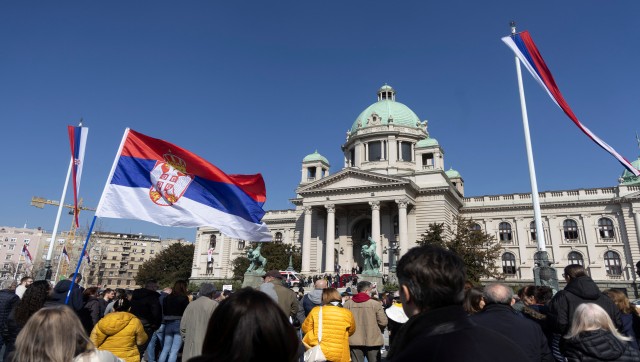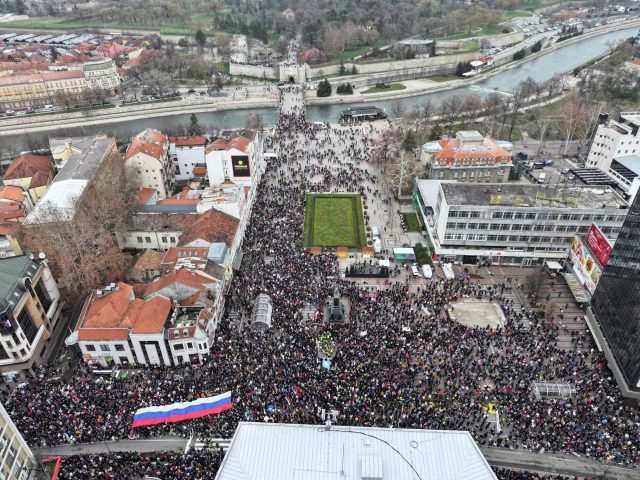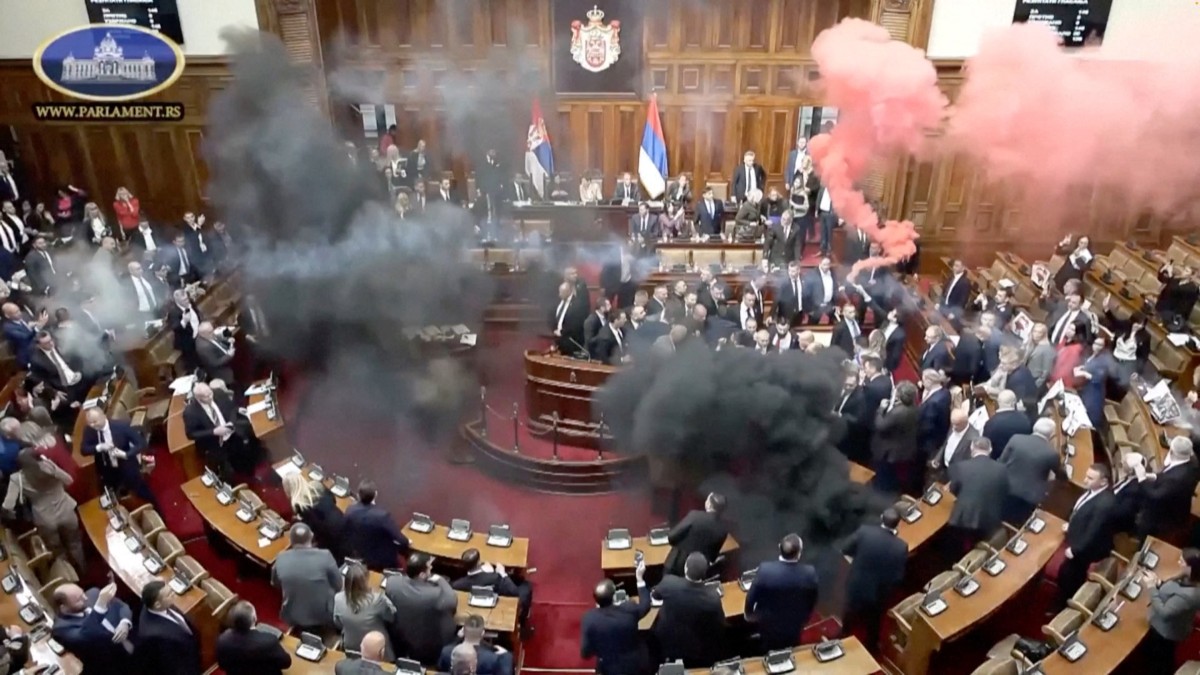Massive drama unfolded at the Serbian parliament on Tuesday after opposition lawmakers threw smoke grenades and tear gas inside the chamber.
Amid the chaos, one legislator reportedly suffered a stroke and is in a serious condition.
The incident highlights Serbia’s severe political crisis, where a populist government has been rocked by months-long anti-corruption demonstrations .
Here’s all we know about it.
What happened at the Serbian parliament?
As the spring session of parliament opened on Tuesday, after the ruling coalition led by the Serbian Progressive Party (SNS) approved the agenda, some opposition politicians ran out of their seats towards the parliamentary speaker and scuffled with security guards.
Others tossed smoke grenades and used pepper spray.
Serbian media said eggs and water bottles were also thrown inside the chamber.
A live TV broadcast showed black and pink smoke billowing inside the parliament, which has seen brawls before, in the decades since the introduction of multi-party democracy in 1990.
Speaker Ana Brnabic said two lawmakers were injured and one, Jasmina Obradovic of the SNS party, suffered a stroke and was in critical condition.
“The parliament will continue to work and to defend Serbia,” she told the session.
As the session continued, ruling coalition politicians debated while opposition lawmakers whistled and blew horns.
Opposition deputies also held signs reading “general strike” and “justice for those killed,” referring to those who died when the station roof collapsed in the city of Novi Sad last November.
Outside parliament, hundreds of protesters stood in silence for 15 minutes to honour those killed.
On Tuesday, the parliament was due to adopt a law increasing funds for universities—one of the main demands of protesting students.
A discussion on PM Vucevic’s resignation was also scheduled.
However, other items put on the agenda by the ruling coalition angered the opposition, triggering chaos.
The session has been adjourned and is due to resume on Wednesday.
What’s behind the chaos?
Serbia has been gripped by unprecedented protests, which were sparked by the collapse of a roof at a newly renovated train station in the second-biggest city, Novi Sad, on November 1.
The incident killed 15 people and critically injured two.
Teachers, farmers, and other workers have joined the protests that began with a student blockade of classes at state universities in December.
Numerous Serbians attribute the tragedy to corruption during President Aleksandar Vucic’s decade in office.
The protests that have occurred in the nation’s capital, Belgrade, as well as in towns throughout the country have also led to the resignation of Prime Minister Milos Vucevic and two other ministers.

People protest in front of parliament building during the opening session of this year’s spring parliamentary convocation where it is expected to note a resignation of PM Milos Vucevic, in Belgrade, Serbia, March 4, 2025. ReutersSo far, prosecutors have charged 13 people in connection with the roof collapse.
What is the government saying?
The ruling coalition says Western intelligence agencies are trying to destabilise Serbia and topple the government by backing the protests.
Several demands made by the student organisers have been met by the authorities in an attempt to put an end to the protests .
A few documents of the station’s repairs have been made public, protesters arrested at rallies have been pardoned, higher education funding has been increased, and criminal charges have been brought against those suspected of harming protesters.
However, they want to keep up their ongoing protests. They also demanded more funding for higher education and the dismissal of the charges against the students who were protesting.

Drone shot of students and opposition supporters holding 15 minutes of silence during a protest over the fatal November 2024 Novi Sad railway station roof collapse, in Nis, Serbia March 1, 2025. ReutersOpposition parties have insisted that the government has no authority to pass new laws.
Leftist lawmaker Radomir Lazovic said the opposition was ready to support the passing of the student-requested education bill, but not the other decisions listed at the assembly agenda.
Lazovic said, “We can only discuss the fall of the government."
He said the only way out of the current crisis would be a transitional government that would create conditions for a free a fair election, a demand that the ruling populists have repeatedly rejected.
Vucic and his ruling right-wing Serbian Progressive Party have imposed a firm grip on power in the past decades despite formally seeking European Union membership.
“This was a failed attempt of the ruling coalition to show it is in control… and (there’s) a potential for an escalation,” Radivoje Grujic, a Warsaw-based consultant told Reuters, commenting on the parliamentary session.
What happens next?
Vucic later said authorities would hold all those deputies involved in the fracas to account, calling it “holliganism.”
Under Serbian law, parliamentary deputies enjoy immunity from prosecution but can lose it if they commit serious crimes.
Speaker Brnabic said Serbia’s parliament “will not back down” after Tuesday’s chaos and said that the MPs who disrupted the session were “terrorists.”
Defense Minister Bratislav Gasic described those behind the incident as “a disgrace to Serbia.”
“The vandalism of opposition MPs has exposed the nature of their personalities and the essence of their political agenda,” Gasic said.
On the other hand, protest leaders called for a major rally in the capital, Belgrade, on March 15 over the incident.
With inputs from agencies
)